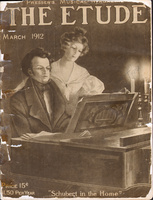The use of violin duets is a much-neglected branch by many teachers, but it cannot be too strongly recommended as a means of developing the musical nature of a pupil. Mr. A. Walter Kramer, in a lengthy article in the Violin World, calls attention to how much good can be accomplished by the practice of good violin duets. He notes that many of the best violin duets are written in sonata form, with an equal division of themes and accompaniment between first and second violin, just as in a sonata for violin and piano, the two instruments have the themes and accompaniments alternately. The practice of violin duets forms an excellent introduction for string quartet and other ensemble work, which the pupil can take up later. Playing violin duets also forms a delightful musical pastime, giving the greatest pleasure to the pupil. Mr. Kramer has prepared a valuable list of violin duets of various grades of difficulty, by eminent composers, as follows:
Easy: Pleyel, op. 8, Six Little Duets; Alard, op. 22, Elementary Duets; Le Beriot, op. 87, Twelve Easy Duets; Mazas, op. 60, Six Very Easy Duets, op. 38, Twelve Little Duets; Kalliwoda, op. 178, Three Very Easy Duets Medium: Alard, op. 27, Four Brilliant Duets; Dancla, op. 43, Three Brilliant Duets; Fiorillo, op. 10, Six Duets; Hauptmann, op. 16, Three Duets; Kalliwoda, op. 116, Three Progressive Duets; Mazas, op. 40, Six Brilliant Duets; op. 62, Three Progressive Duets. Difficult: De Beriot, op. 57, Three Concert Duets; Hermann, op. 7, Three Brilliant Caprices; Kalliwoda, op. 70, Two Brilliant Duets; Maurer, op. 61, Three Concert Duets; Molique, op. 2, Three Concert Duets; Rode, op. 8, Three Duets; Spohr, op. 3, Three Duets; op. 9, Two Duets; op. 39, Three Duets; op. 67, Three Duets; Viotti, op. 22, Three Grand Concert Duets.
The above list contains some of the most interesting and melodious violin duets in musical literature, and some of those best adapted for the use of students.
Theodor Leschetizky, of Vienna, the eminent teacher of piano, who was the teacher of Paderewski, strongly advises musical students to play in public frequently. He considers playing for audiences as invaluable for developing the powers of expression of the student, since the latter will gain many new ideas of expression and style while under the magnetic bond of sympathy which is created between audience and performer. Every teacher notices that the really talented pupils in his class play very differently before an audience from what they do in the lesson hour. The excitement and influence of the audience inspire them to heights of expression that they would never dream of in their private practice. It is the same with actors; they cannot do their best work except under the stimulus and applause of an audience. Experienced theatregoers are always anxious to attend a performance when there is a full house, because the performance is so much better.
While it is certainly not wise for a teacher to rush his pupils before an audience before they are technically prepared, yet they should be given frequent opportunity for public work as soon as they are even approximately ready. My own experience has been that the mysterious sympathy of an audience can teach the young violin soloist secrets in expression and dramatic force, which the most eminent teacher could not possibly do. Besides, frequent public appearances are the sole means of overcoming that distressing monster—stage-fright.



